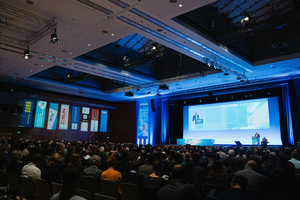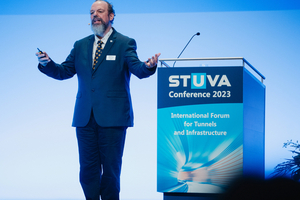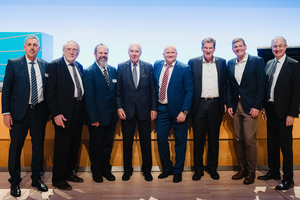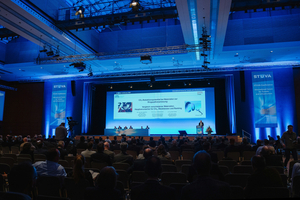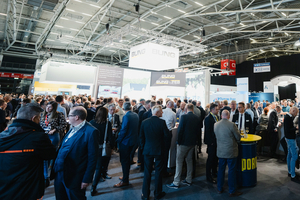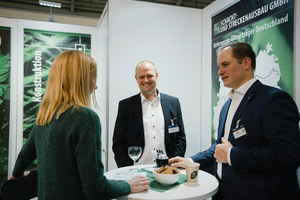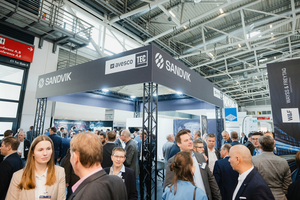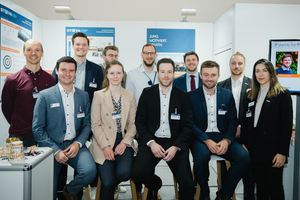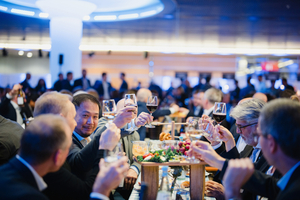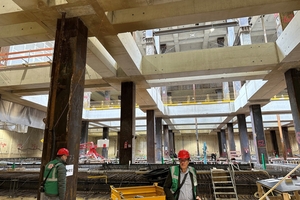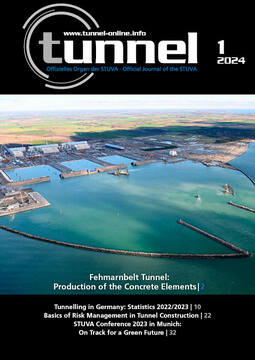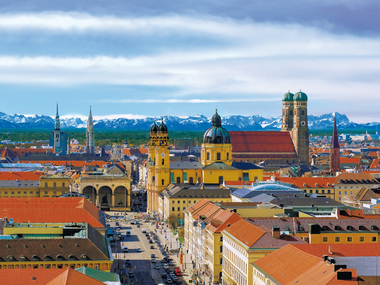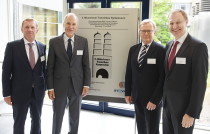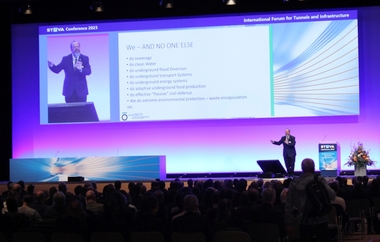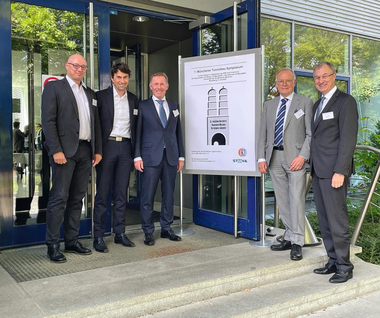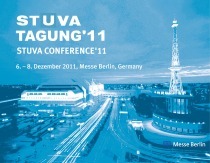STUVA Conference 2023 in Munich: On Track for a Green Future
One thing was already clear during the preparations: the conference in Munich is definitely something very special. After all, the second ever STUVA Conference was held here in the Bavarian capital exactly 60 years ago, paving the way for the STUVA‘s long success story. In 1963, they were proud of the record number of 150 experts from the tunnelling industry who attended the presentations at the then one-day event. Nobody could have imagined at the time that this rather modest beginning would become one of the world‘s largest and most important industry gatherings over the decades. With a total of 4300 participants from 8 to 10 November 2023, there were almost 30 times as many participants in Munich as in 1963. Never before have so many experts attended a STUVA Conference. And the STUVA-Expo trade exhibition accompanying the conference also set a new participation record, covering an area of around 8000 m².
The STUVA Conference (Fig. 1), which takes place every two years, is particularly good at one thing: recognising current topics in the industry, providing the appropriate impetus and providing experts with a suitable forum for discussion. It is therefore no wonder that this year‘s event focussed on the pressing human issues of resource conservation and climate protection. In particular, the building materials required, such as cement, and the large amount of mineral „construction waste“, such as soil and rock, have so far had a poor climate balance. This is doubly regrettable as mankind urgently needs to create more rather than fewer underground structures. After all, functioning underground structures are already a key pillar of a flourishing economy today and will be even more so in the future. They ensure the supply of water and energy, they relieve traffic congestion in city centres thanks to underground/metro systems and underground roads, they guarantee safe transport connections over long distances and across large areas, and they enable underground disposal systems such as sewage systems.
Construction and Operation of Environmentally Friendly Underground Infrastructures
The STUVA has therefore deliberately focussed this year‘s conference on the many opportunities to increase resource efficiency and the development of new process technologies in the sense of a circular economy. After all, the construction and operation of underground infrastructures that are significantly more environmentally friendly can already be realised today and, in view of climate change, there is no alternative. In his opening speech, Prof Martin Ziegler therefore warned against the emerging “climate fatigue” in large parts of the population and a growing sentiment against the construction of new metro tunnels: „To ensure broad acceptance of transport tunnel construction, we must build as resource-efficiently and sustainably as possible in future! After all, well-planned tunnels are essential for a successful transport transition with efficient public transport.“
Also the current President of the International Tunnelling and Underground Space Association (ITA), Arnold Dix, who had travelled from his home country Australia especially for the STUVA Conference, appealed to the conference participants to put their own knowledge at the service of environmental protection and to align their own actions with sustainability criteria: “Who, if not us? The world needs us now! Our technical expertise is in demand, because nobody else can plan, build and operate underground spaces.” The ITA, Arnold Dix continues, is currently working hard to develop transparent sustainability assessment tools specifically tailored to the underground, which will help decision-makers around the world to implement projects based on scientific and technical methods: “Now it is our duty to explain to the world why underground infrastructure is a legitimate and proven intergenerational way to meet the most pressing needs of our people and our planet.” (Figs. 2 and 3).
In his welcoming address, VDV President Ingo Wortmann found clear words in favour of further expanding public transport. “Growth and prosperity come from better connections and integration,” said Wortmann. He expressly welcomed the introduction of the Deutschland-Ticket as a building block for the mobility turnaround, but it remains the case that public transport services in particular will determine whether the climate protection targets are achieved by 2030. To achieve this, we need an expansion and modernisation offensive for public transport systems. In addition to a significant increase in public transport capacity, this also means new tram and underground railway projects as well as the renovation, repair and barrier-free expansion of existing infrastructure. And, to put it bluntly: in highly dense areas, this naturally includes the tunnel infrastructure as part of the solution, according to the VDV President.
Lecture Programme
After the opening speeches, the actual lecture programme began. For two days, over 60 specialist lectures were held in the parallel lecture series “Tunnelling” and “Tunnel Operation/Planning”. As is customary at STUVA Conferences, all presentations were translated into English by simultaneous interpreters for the numerous guests from abroad. The attentive listener quickly realised that all the appeals in the opening speeches for ecological action were by no means mere lip service. The green revolution in the tunnelling industry has long since gained momentum! The recycling of excavated material is now common practice and saves many transport journeys and high landfill costs. Even segment production from recycled material directly on the construction site is already a reality and the real-time characterisation of excavated tunnel material in EPB tunnelling offers solutions for a resource-efficient circular economy. New materials for annular gap grouting offer great CO2 reduction potential and even the production of bentonite suspensions, for which a great deal of precious drinking water is otherwise consumed, can be significantly more ecological with environmentally friendly utilisation and subsequent return of river water. The presentation on the first “Net-Zero cement plant”, which is to be built in Germany by 2029, was also promising in terms of CO2 savings. The results of the pilot study funded by the Federal Ministry for Economic Affairs and Climate Protection are excellent. The aim is to utilise green hydrogen produced from renewable energy.
DAUB Lecture Block “Sustainability and CO2 Reduction in Tunnelling”
The lecture block “Sustainability and CO2 reduction in tunnelling” was dedicated to the German Committee for Underground Construction (DAUB), which celebrated its 50th anniversary in 2023. The session was opened by the current chairman Dr Klaus Rieker. In a brief introduction, he presented the DAUB and its objectives. According to its statutes, the DAUB is committed to the promotion and further development of underground infrastructure. It always has its finger on the pulse of the times and is orientated towards the current needs of the industry. Consequently, sustainability in tunnelling is also a topic that is currently being addressed.
Rieker began by briefly recalling the history of the DAUB. As early as 1970, the OECD had noted that the construction of transport tunnels was increasing rapidly worldwide and therefore decided to promote international cooperation in tunnelling and the development of urgently needed common rules. It recommended that the member countries create a central body for tunnelling in their own country and thus facilitate fruitful international cooperation. This was the trigger for the foundation of the DAUB. Since then, the DAUB has been collecting and disseminating technical information on underground construction and collaborating nationally and internationally in the development of laws, standards, guidelines and safety regulations. It does all this very successfully, but more in the background than on the big political stage. The visible results of its work are above all the recommendations that can be downloaded free of charge from the DAUB website www.daub-ita.de.
In the last three years alone, recommendations have been published on topics as diverse as BIM, project risk management, life cycle costing, the selection of tunnelling machines and a guide to health and safety on underground construction sites. DAUB recommendations are regarded throughout the industry as the state of the art and are equally accepted and utilised by authorities and clients, the scientific and planning communities and the business community.
However, the positive trend towards more ecological tunnels was not only evident in this block of presentations. Even innovations that at first glance appear to have nothing to do with the environment are contributing to significantly lower resource consumption. For example, the development towards fully automated tunnelling is unstoppable. The resulting shorter construction times are also environmentally friendly factors. The rapid development of Building Information Modelling towards a genuine digital twin of the respective structure also gives hope. Such a twin not only enables planning for resource-saving construction, but also ecologically and economically optimised operation over decades.
Of course, it is not possible to go into all the presentations here. There were simply too many. Whether
technical solutions in mechanised tunnelling, safety and digitalisation, tunnel renovation or major international projects - there were separate blocks of presentations on all these topics with cutting-edge projects and first-hand information. And of course, the 2nd Core S-Bahn Line and the many other current underground construction projects in the Munich region also took centre stage on the second day. Anyone wishing to review the full range of topics covered at this year‘s STUVA conference is recommended to read the comprehensive conference proceedings [1]. It contains the long versions of all presentation.
STUVA Expo with Great Results
On both days, the Expo exhibitors‘ stands were therefore also well frequented outside of the lecture breaks. No wonder, as hundreds of trade visitors who had registered in advance and were able to visit the Expo free of charge had attended alongside conference participants. As a result, almost all exhibitors had satisfied faces at the end. Once again, it was confirmed that a company presence at the STUVA-Expo is an excellent opportunity to market its own products and services, some of which are highly specialised and tailored to the tunnelling industry. After an eventful and long first day, there was a welcome reward in the evening. The traditional festive evening, which began with a champagne reception kindly sponsored by the Socotec Group, took place in a rustic Bavarian-style hall at the ICM and was booked out to the last seat. Over 1700 conference attendees gathered to enjoy hearty food and drinks on rustic beer benches and enjoyed a successful evening that only ended in the early hours of the morning. Once again, the late finish was due in no small part to the free beer served by Keller Grundbau, which brought the evening to a close.
Excursions to the 2nd Core S-Bahn Line
Fully Booked
As always, the third day of the STUVA Conference was reserved for the specialist tours. Once again this year, the STUVA managed to put together a highly interesting programme of visits, which admittedly was not too difficult given the current high level of construction activity in Munich. The excursions to the major construction sites at Laim, the main railway station, Marienhof and Portal West, which are all part of the major project for the 2nd Core S-Bahn Line, were particularly popular. Figure 10 shows participants of the STUVA excursion to the deep excavation pit of the Marienhof station 22 metres below ground level. Such exclusive insights into the construction site under the expert guidance of project managers are only available to participants of the STUVA Conference.
Ready for the Next Big Event:
In 2025, the STUVA Conference
Will Take Place in Hamburg
The STUVA Conference 2023 ended with the sightseeing programme on the third day and the participants set off on their journey home. Now it‘s another two-year wait until the next STUVA conference takes place at the other end of Germany from 25 to 27 November 2025. The venue will be the Hanseatic city of Hamburg and, of course, the spectacular construction sites of the new U5 line will take centre stage. STUVA is already looking forward to welcoming many visitors and would like to thank all sponsors, speakers and exhibitors from the bottom of its heart. Without the broad support of the entire tunnelling industry, an event like the STUVA Conference and Expo would not be possible.

